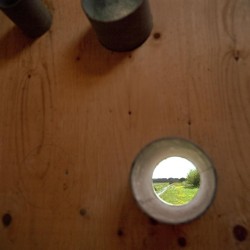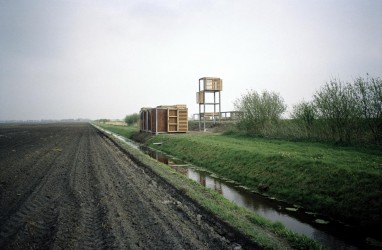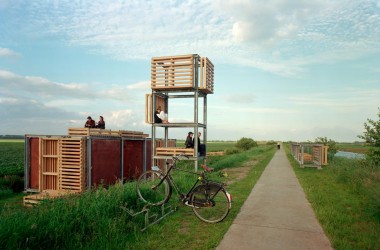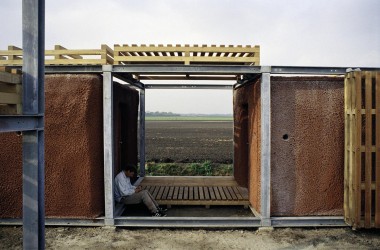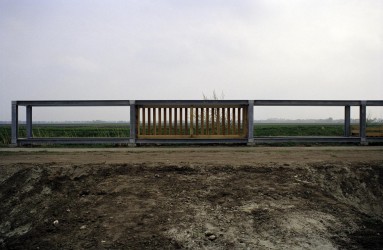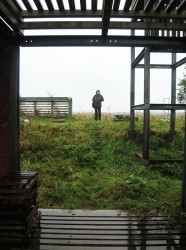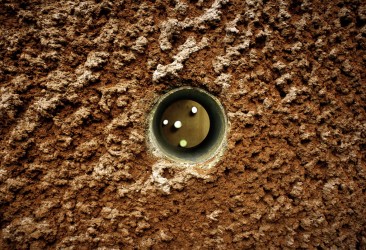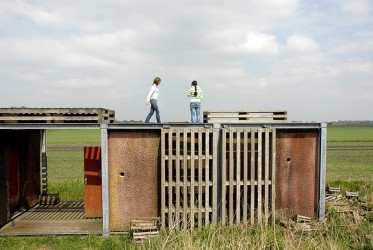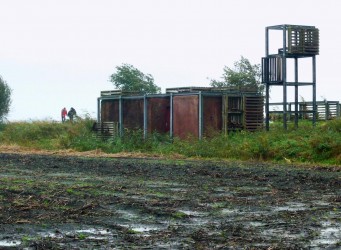Sculpture, amendable to extension and modification, on loan to a private individual, in former peat lands near Groningen. The sculpture serves as a dwelling for seclusion, rest and study, and forms a gateway to the landscape.
See: http://www.otium-w.eu/hootdframeset/hoofdframeset.htm
Observatorium makes works of art that are "unfinished" and which develop in time. Civilization is similarly not a snapshot in time but a process. Maintenance is part of that development, not of the status quo.
The Semslinie Art Route
The Netherlands, like many other countries, reserves a small percentage of every public building budget for art. This applies not only to actual buildings but also to landscape redevelopment projects. The Semslinie Art Route comprises nine works of art commissioned to commemorate a major revitalization of the landscape, involving the merging of farms, the redistribution of ditches and fields and improvements in road infrastructure in the former peat-extraction "colonies" of Groningen and Drente. Wherever you stand in this Peat District, you have to picture a layer of peat reaching well above your head, to imagine what the original landscape must have been like. You stand on the sandy bed of what was once an immense black sponge measuring some 40 x 70 kilometres – peat that has been extracted, transported and burnt as fuel.
The Semslinie Art Route is an ambitious project intended to help boost the economy of a relatively neglected area. The farms will be larger but there will also be more room for recreation and nature. The goal of the art project was to draw attention to the quality and character of the landscape. The curator/artist Loes Heebink took the Semslinie, a 400 year old feature running in a perfectly straight line through the landscape for about 40 kilometres, as the basis. As she stated, "The works of art must not only enter into a dialogue with its specific surroundings, but they must establish a connection between the present, past and future."
The location assigned to Observatorium was in the middle of a large area of treeless potato fields, backed onto by surrounding farms along the horizon. The peat districts of the Netherlands are associated with economic hardship and empty, disconsolate, unappealing countryside. It was Observatorium's first visit to this kind of region. The dwellings for seclusion in New York and Hoeksche Waard were child's play in comparison to the pioneering work that would be needed here. Once the peat had been extracted, the inhabitants had to make a new start somewhere else. Topographical maps from the 19th century, from 1950 and from 1990 show that the immediate surroundings of the Leinewijk Canal have been thoroughly dug over no less than three times in the hundred years since the first colonization. Each time, the farms, the fields and the roads grew larger, and the population and the number of trees shrank. The future does not look much different; another round of digging up, reconstruction and settlement is likely.
Where potato fields now lie to the north of the Leinewijk Canal, a new extension is planned for Hoogezand, a town which to an outsider seems to consist solely of new extensions. Starting again, reconstruction and settlement indicate optimism, but when it happens with such frequency it all has an air of desperation.
The location and its history obliged Observatorium to act as pioneers. Another artist may read something in history that inspires him to do something with a laser beam, an archway or a machine, but, for Observatorium, designing and constructing a work of art is tantamount to settling in a place. What symbolic gesture could hold its own on this windswept plain? Who would guard it amid this emptiness against the predations of vandalism? This is no community or habitation here waiting with open arms to embrace a work of art. The elements are so overwhelming here that only a work portraying the struggle against these elements would suffice. Then it would be no more than logical that someone would settle here: the pioneering spirit is the sculpture. The work must form part of the perpetual cycle of this terrain's history, of its exploitation, settlement and resettlement. Following the two previous projects of temporary dwellings for seclusion, this work would have to endure the test of time.
One and all
Art is free but a dwelling must meet a list of requirements. Observatorium drew up its own programme. The landscape here is subject to continual change and the dwelling must change along with it. The location is on the edge of the Peat District so the sculpture had to be a gateway to that landscape. Recreation is considered ever more important, so passing tourists must be able to stop here and take in the view.
location: Semslinie Art Route, Hoogezand
year:2003
images:
